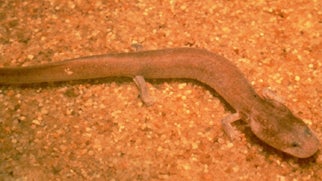SCIENTIFIC NAME:
Gyrinophilus palleucus palleucus (McCrady)
OTHER NAMES:
None.
STATUS:
Rare in Interior Plateau and Cumberland Plateau of Southwestern Appalachians. Restricted to limestone caves containing water. Approximately 20 Alabama locations, all in Tennessee River drainage. Controversial as may acually be isolated populations of Gyrinophilus porphyriticus. Populations vulnerable nonetheless. HIGH CONSERVATION CONCERN.
DESCRIPTION:
A neotenic, stygobitic salamander attaining a maximum total length of 15.5 centimeters (approx. six inches). Normally with gills throughout life; gills bright red and bushy or reduced; eyes depressed and greatly reduced in size; head long, snout spathulate; lateral line well developed with noticeable unpigmented sensory pores; tail laterally compressed with a well-developed caudal fin. Pigmentation variable, overall coloration salmon to pale flesh-pink; back may be faintly washed with brown; belly immaculate. Metamorphosed individuals in wild extremely rare and short lived, but are produced easily in laboratory. In such, gills are resorbed as is caudal fin. Color of back becomes faint yellow with irregular but distinct brown markings. Head extremely flattened and gular region greatly depressed. Eyes become enlarged, well pigmented, and protuberant, differing sharply from those of neotenes. Alabama populations predominantly of subspecies G. p. palleucus, with evidence of G. p. necturoides in populations along the western edge of Cumberland Plateau (McCrady 1954; Brandon 1965, 1967; Simmons 1975, 1976; Petranka 1998).
DISTRIBUTION:
Restricted to karst regions from the Interior Low Plateau and Ridge and Valley Province of Tennessee, the Cumberland Plateau of Alabama, and across the Tennessee River Valley in northern Alabama. One outlier is found in northwestern Georgia. Recorded from eight Alabama caves in Jackson County, three in Marshall, two in Colbert and Limestone, and one each in DeKalb and Madison Counties (Cooper 1968, Cooper and Cooper 1968). Four additional unconfirmed populations have been reported for Jackson County.
HABITAT:
Restricted to limestone caves containing water. Inhabit rimstone pools, deep still pools with a groundwater connection, and pools and runs in sizeable underground streams. Specimens have been collected outside of caves, at the mouths of springs (Petranka 1998). Majority of populations occur in Jackson County where there is optimal habitat, i.e., an abundance of large (1.6-8 km [1-5 mi.] in extent) stream caves with an associated sinkhole.
LIFE HISTORY AND ECOLOGY:
Very little known. Presumed to have low metabolism, growth, reproductive potential, and a longer life span as do other cave forms. Evidence from surveys suggests that populations appear to be quite low. In summer and fall, individuals tend to remain isolated in cave pools, inhabiting a relatively small home range. During winter and spring floods, they apparently retreat to deeper aquatic strata. An opportunistic predator eating essentially anything it can capture and swallow. Aquatic insects and crustaceans, especially amphipods and isopods, comprise the major prey taken. Preyed upon by epigean fishes, crayfish, and frogs. Stygobitic crayfish, shrimp, amphipods, and cavefish are associates. Cannibalism has been reported. Breeding by females may not take place every year. Courtship, laid eggs, and newly hatched larvae have not been described. Small larvae have been found in December and February, suggesting that reproduction takes place in fall or winter (Simmons 1975).
BASIS FOR STATUS CLASSIFICATION:
Surveys conducted between 1995 and 1999 redocumented occurrence in seven of 12 caves surveyed; no specimens found in five. Although habitat conditions appeared adequate in caves where documented but not relocated, and new populations have been reported, the species is disjunctly distributed making isolated populations vulnerable to local extinction (Godwin 1995, 1999, 2000). Populations are susceptible to events that degrade the aquatic conditions of the caves. Data on habitat requirements, life history, and ecology are still needed. As indicated by surveys, a large proportion of all known localities could have declining or extirpated populations. Two populations are under federal ownership, but still vulnerable to outside threats.
Author: James C. Godwin






